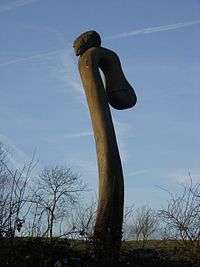Shepherd's crook


The shepherd's crook is an important albeit primitive device used by shepherds. Sheep can feed on rough pasture which is unsuitable for cattle or agriculture, including mountainous terrain. Seasonal herding along mountainous routes gave rise to what are now known as drovers' roads. A strong, multi-purpose stick can be used for balance, examining dangerous undergrowth and for defence against attack by predators.
Symbolic Use

The innovation of a hook facilitates the recovery of fallen animals by ensnaring them by neck or leg. For this reason the crook has been used as a religious symbol of care (particularly in difficult circumstances) such the badge of office for a Mithraic pater and the Christian bishops' crosier.[2]
The shepherd's crook is also symbolic of the spiritual Kundalini energy described in Eastern religions, which rises up the spine and over into the third eye (pineal gland) and crown chakra (pituitary gland) when a being reaches enlightenment.[3]
The shape of the Shepherd's crook is also named the "Johnson Curve" for highly intensive engineering calculations.
Thalia, Muse of comedy in Greek mythology, was usually seen holding a shepherd's crook.
The shepherd's crook and the flail (an agricultural tool) are insignia of pharaonic authority: the Crook and flail.
References
- ↑ Morris Eaves, Robert N. Essick, and Joseph Viscomi (eds.). "Songs of Innocence, copy B, object 4 (Bentley 5, Erdman 5, Keynes 5) "The Shepherd"". William Blake Archive. Retrieved January 17, 2014.
- ↑ Caeremoniale Episcoporum (Vatican Polyglott Press, 1985)
- ↑ Kundalini Rising: Exploring the Energy of Awakening p.303. Retrieved 25 March 2014. (Sounds True Inc, 2009)